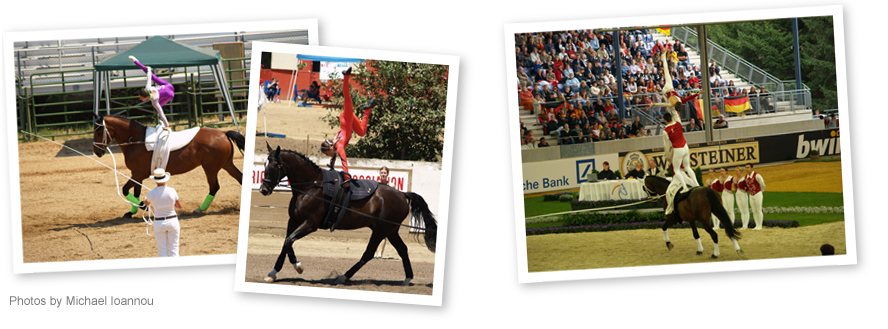About Vaulting
Equestrian vaulting is the art and sport of dance and gymnastics choreographed to music and performed on the back of a moving horse. The horse is controlled by a longeur and canters in a circle as the vaulters perform their routines. Vaulting can be done recreationally, as part of a therapy program for those with physical or mental disabilities, or competitively beginning at the walk and progressing to the canter. In competitive vaulting, both the horse and the vaulter are scored on their performances with the ultimate goal being a fluid routine with perfect harmony between horse and vaulter.
Competitive Vaulting is an international equestrian discipline recognized by the Federation Equestre Internationale (FEI). Although it is not an Olympic sport, top vaulters from around the world do compete in the FEI World Equestrian Games and the FEI Vaulting World Championships. In the United States vaulting is governed by the American Vaulting Association and The United States Equestrian Federation. As of 2012, the AVA had more than 100 clubs across the country. Lizzie vaults with the Mt. Eden Vaulting Club in Saratoga California.
Competitive vaulting can be done individually, in pairs, or as part of a team with up to three people on the horse at a time. Both individuals and team members perform a set of individual exercises (compulsories) which are judged against an objective standard. Individuals at the top levels also perform a Technical Test which features set moves integrated by the vaulter into a unique routine. The Technical score includes a composition component which reflects artistry and creativity as well as scores for the actual moves. Individuals, pairs ( called pas de deux) and teams (called squads if they compete internationally) also perform freestyle routines which are judged on composition, degree of difficulty, and performance.
Compulsories
There are nine graded compulsories: mount, basic seat, flag, mill, scissors parts 1 & 2, stand, flank and dismount. The goal of these exercises is to promote safety and horsemanship while riding and vaulting. Vaulting began as a military discipline when the ability to safely mount, dismount, sit, stand and otherwise move freely on the back of a cantering horse was vital on the battlefield. These basic exercises are the foundation for all safe vaulting and beginners to world champions perform versions of these same exercises.
Individual Technical Test
The Technical was introduced in the mid 2000’s as a hybrid between the “anything goes” freestyle and the strict compulsory regimen. The exercises are prescribed, and designed to showcase specific qualities such as strength and flexibility. The prescribed moves change from time to time but vaulters are scored on jump force, coordination, suppleness, balance, and strength. The composition score rewards individuality and allows the vaulters freedom to include their favorite skills. There is also an overall performance score.
Individual Freestyle
The individual Freestyle is scored on composition, degree of difficulty, and performance. Performance is worth twice as much as the others to encourage safety. A well designed freestyle will show a variety of skills in a range of places on the horse (neck, back, sides, rear) with the vaulter facing different directions. Both static and dynamic moves are performed and the composition should include graceful transitions. At the top levels the music choice is up to the vaulter and can range from classical to hip hop to show tunes. Costumes and choreography add to the composition.
Team Freestyle
The A Team Freestyle is the heart of competitive vaulting. One longuer, one horse, six vaulters, and four minutes. Top teams manage to balance vaulters of different sizes, experience levels, ages and personalities into a cohesive unit capable of performing complicated acrobatic routines requiring strength, stamina, teamwork and trust. Strong bases lift tiny flyers above their heads. Mid size vaulters support tall triples and provide graceful and creative transitions.
Watch the Mt. Eden Sun Team’s 2012 Freestyle here.
